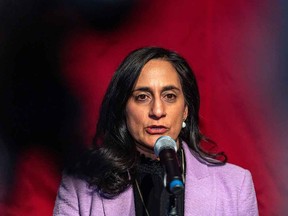Trump’s proposed levies could compel Canada’s biggest banks to report higher provisions for credit losses
Article content
The economic uncertainty stemming from U.S. President Donald Trump’s proposed tariffs could compel Canada’s biggest banks to report provisions for credit losses that are higher than what analysts had previously expected when the lenders release their quarterly results next week.
Article content
Article content
Such a move could dampen the mood for the quarter ending Jan. 31 that otherwise is expected to reflect positive momentum due to growth in net interest margins and strong capital market results, analysts say.
Advertisement 2
Article content
“Based on where our estimates stand today, we expect most banks to handily beat consensus, provided the banks do not take this opportunity to build higher performing reserves,” Mario Mendonca, an analyst at Toronto-Dominion Bank, said in a note on Feb. 7.
Jefferies Inc. analyst John Aiken said the outlook for 2025 and beyond is “quite binary” based on whether the Trump administration will impose tariffs.
“We expect much of the conversation around the quarter will centre on what the potential implications could be and what, if anything, the bank management teams can do to mitigate the negative impact,” he said in a note on Feb. 18.
Rising provisions for credit losses (PCLs) — the money lenders keep aside for loans that might go bad — have negatively impacted the Big Six in recent years as borrowers found it difficult to pay back loans amidst persistent inflation and prolonged high interest rates.
Analysts expected the situation to gradually improve this year after the Bank of Canada started a series of rate cuts last year and prices rose at a slower rate, but Trump’s proposed tariffs on Canadian goods have led to a cloudy outlook, analysts say.
Article content
Advertisement 3
Article content
“We had become increasingly convinced that credit losses were near a peak and that the banks could be in a position to release performing allowances sooner than later,” Paul Holden, an analyst at CIBC World Markets Inc., said in a note on Feb. 14. “We have less conviction in that view given the tariff risk.”
PCLs are a key credit metric for measuring the health of a bank’s loan book and, by extension, the ability of households and businesses to pay their debts.
If the economic picture becomes brighter, banks can release some of their PCL reserves, but Holden and other analysts don’t expect that to happen anytime soon.
“We expect the banks will be adding to performing provisions with the first-quarter results,” he said. “If tariffs against Canada are implemented, then our expectation for impaired PCLs would need to change significantly. The outcome on tariffs is unknown, but it is now a risk that we need to consider in our outlook.”
Darko Mihelic, an analyst at RBC Capital Markets, has also revised his expectations and lowered the expected average earnings per share of the large banks he covers, primarily because of the expected impact of higher-than-expected PCLs.
Advertisement 4
Article content
“We expect all large banks … to build larger performing PCLs than we previously believed,” he said in a note on Feb. 14. “We expect the banks’ base-case economic scenarios to reflect more of a recessionary economy and we also believe pessimistic scenario assumptions may become more pessimistic.”
Gabriel Dechaine, an analyst at National Bank Financial Inc., doesn’t expect higher provisions to impact banks this quarter, but said the probability of it increasing in the future quarters has risen.
“We expect banks to inject greater conservatism into their credit guidance,” he said in a note on Feb. 17. “We note the probability of massive provision builds like the ones we saw during the pandemic is low, given the likelihood of government support programs.”
Dechaine forecasts a similar scenario when it comes to loan growth and expects the “tone” to become more conservative as credit demand from retail and commercial borrowers is “chilled” by the economic uncertainty.
He compares the current situation to the start of 2024, when the Big Six stocks were held back until the Bank of Canada started cutting rates, after which they rallied in the second half. This year, the banks are being weighed down by trade tensions.
Advertisement 5
Article content
“However, we believe progress will be made and tensions will dissipate, albeit not until the midpoint of the year,” he said. “Until then, we expect the group’s performance to be under pressure.”
Analysts are particularly keeping an eye on the Bank of Montreal when it comes to PCLs. It was forced to set aside significantly more money than expected to cover bad loans in the past two quarters and, as a result, missed analysts’ expectations.
Following last quarter’s results, BMO’s chief risk officer said the lender’s credit deterioration had peaked, so analysts will be looking for specific signs that support that thesis.
“We hope to see stage 3 PCLs at or below our estimate and, more importantly, other signs like delinquencies (formations) and declines in the watchlist, if not outright guidance that PCLs will continue to march lower from Q1/25 levels,” Mihelic said.
While tariffs are expected to impact all the banks, Holden said the Bank of Nova Scotia might be impacted more significantly than the group and so he downgraded his rating on the bank after upgrading it five months ago.
Advertisement 6
Article content
“We generally prefer not to change ratings this quickly (upgraded September 2024), but the macro environment has changed significantly,” he said. “We could return to a more positive call if Mexico and Canada are able to negotiate relatively harmless tariffs. Until that happens, we think it will be hard for the stock to be a relative outperformer.”
Scotiabank’s North American corridor strategy announced in 2023 focuses on growing in Mexico and building closer ties to companies doing business across Canada, the U.S. and Mexico.
“It generates the least amount of earnings from the U.S. relative to Canadian peers and earns roughly 12 per cent from Mexico,” he said.
Recommended from Editorial
-

Five banks quit global climate alliance
-

Equitable Bank CEO cautiously optimistic
Toronto-Dominion Bank will be another lender analysts will be putting under the microscope as it undergoes a strategic review after being sanctioned by U.S. authorities last year for failing to prevent money laundering at its branches across the border.
As TD looks to revamp its anti-money laundering program, its non-interest expenses should be worse than the other banks, Holden said. TD expects expense growth during fiscal year 2025 to be about five per cent to seven per cent, but he worries that might climb due to the “complexities “linked to the anti-money laundering remediation.
• Email: nkarim@postmedia.com
Bookmark our website and support our journalism: Don’t miss the business news you need to know — add financialpost.com to your bookmarks and sign up for our newsletters here.
Article content
Economic decline due to tariffs weigh on Big 6 banks
2025-02-20 12:41:19






